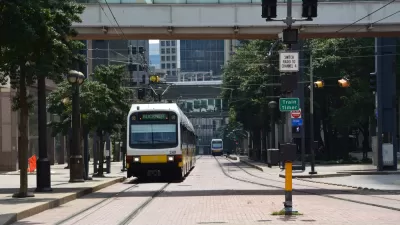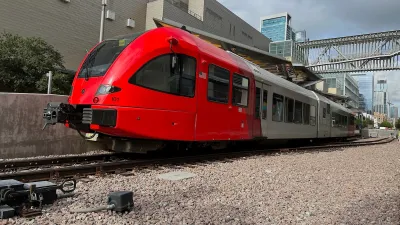In Dallas poorer people often rely on transit, a familiar pattern throughout the United States. But when car ownership grants access to opportunity, this can be a problem.

In car-friendly Dallas, poverty often means lack of access to the dominant form of transportation. Brandon Formby reports on the conditions people like Artis Frnak face daily. From the article: "A car could provide faster access to a better job, but loan payments, maintenance and insurance would eat away at salary gains. So it makes more financial sense to Frank to live near a DART bus line and find work close to public transit."
"That's how life goes along the poverty line in car-centric cities like Dallas, whose 20th-century growth birthed highways that became developmental skeletons for suburbs where the middle class have fled for decades. Left behind is an urban core with housing and socioeconomic problems — and infrastructure built for cars that many poor people can't afford."
For many poor city-dwellers, a car is prerequisite to advancement. "[Resident] Gaddis' car isn't about getting around quicker in the life she has, though. It's about improving her job prospects. She plans to enroll at Remington College in Garland so she can be a medical assistant. Using public transit to juggle education, child care and work would be too cumbersome."
The city's Neighborhoods Plus development report [pdf] outlines its current efforts to address these disparities. The Neighborhoods Plus plan will approach transit planning by gathering data on individual area needs. The goal is to make multiple mobility options available to residents.
FULL STORY: Stemming poverty in Dallas requires rethinking mobility

Study: Maui’s Plan to Convert Vacation Rentals to Long-Term Housing Could Cause Nearly $1 Billion Economic Loss
The plan would reduce visitor accommodation by 25,% resulting in 1,900 jobs lost.

North Texas Transit Leaders Tout Benefits of TOD for Growing Region
At a summit focused on transit-oriented development, policymakers discussed how North Texas’ expanded light rail system can serve as a tool for economic growth.

Why Should We Subsidize Public Transportation?
Many public transit agencies face financial stress due to rising costs, declining fare revenue, and declining subsidies. Transit advocates must provide a strong business case for increasing public transit funding.

How to Make US Trains Faster
Changes to boarding platforms and a switch to electric trains could improve U.S. passenger rail service without the added cost of high-speed rail.

Columbia’s Revitalized ‘Loop’ Is a Hub for Local Entrepreneurs
A focus on small businesses is helping a commercial corridor in Columbia, Missouri thrive.

Invasive Insect Threatens Minnesota’s Ash Forests
The Emerald Ash Borer is a rapidly spreading invasive pest threatening Minnesota’s ash trees, and homeowners are encouraged to plant diverse replacement species, avoid moving ash firewood, and monitor for signs of infestation.
Urban Design for Planners 1: Software Tools
This six-course series explores essential urban design concepts using open source software and equips planners with the tools they need to participate fully in the urban design process.
Planning for Universal Design
Learn the tools for implementing Universal Design in planning regulations.
City of Santa Clarita
Ascent Environmental
Institute for Housing and Urban Development Studies (IHS)
City of Grandview
Harvard GSD Executive Education
Toledo-Lucas County Plan Commissions
Salt Lake City
NYU Wagner Graduate School of Public Service




























